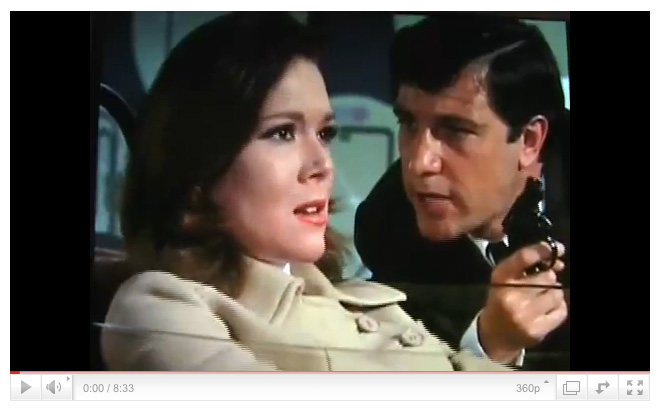
The Mother of Sim Racing
April 7th, 2011 by DavidP
When my iRacing colleague Otto Szebini e-mailed me a series of photos from the NVIDIA home office showing, among other things, a Jim Clark tribute Lotus/sim racing chassis, it triggered a complex series of memories . . . not least of which (thanks to a timely reminder from David Malsher at Racer magazine) are those associated with this day – 43 years ago — when the man many believe to have been history’s greatest race driver lost his life in an accident during a Formula 2 race.
The image of Clark’s car perched in front of NVIDIA’s giant monitor jogged some happy memories as well, including those associated with one of history’s earliest sim racers: Mrs. Emma Peel. For those deprived souls for whom the name “Emma Peel” does not ring any bells, allow me to explain. When Clark was winning races from Spa and Kyalami to Indianapolis and Milwaukee, Mrs. Peel was the female lead in a BBC television show called The Avengers, a suave, smart, witty send-up of the spy/secret agent genre. The role of Mrs. Peel was played by Diana Rigg (now Dame Diana Rigg) whose sparkling, flirtatious chemistry with Patrick McNee (in the role of John Steed) made the show a delight . . . and whose regular appearance in an assortment of Carnaby Street-inspired cat suits captured the, er, imagination of adolescent males of all ages around the world.
As agents of an MI5-like organization, Steed and Mrs. Peel (Mr. Peel was mysteriously MIA) saved England from a succession of devious villains, Soviet-esque saboteurs and demented psychopaths. One memorable episode found Mrs. Peel at the wheel of one of the world’s first sim racing machines: a Lotus 31 “magically” connected to an endless film loop of a lap of the Brands Hatch club circuit.
When Otto Szebini e-mailed me a series of photos from the NVIDIA home office showing, among other things, a Jim Clark tribute Lotus/sim racing chassis, it triggered a complex series of memories
Sure it was cheesey, even for 1967. The speed of the film was controlled by a separate console featuring a massive dial marked “0 – 160 mph” with a manually adjustable needle. Best of all, the chassis delivered an electric shock (of variable intensity) to the driver when he/she put a wheel off track, spun or crashed. So much simpler than iRatings and Safety ratings, don’t you think? Steady Nim and Shannon!
Anyway, after kidnapping Mrs. Peel, sticking her in the race car and handcuffing her to the steering wheel, the bad guy speeds-up the film and increases the voltage “penalty” to lethal levels in the hopes of extracting top secret information from her. Ultimately, Mrs. Peel is lapping Brands Hatch at upwards of 160 mph (!) before Steed arrives to save the day . . . but not before a ditzy bystander unwittingly puts the video in reverse, forcing our talented heroine to lap Brands Hatch in reverse without putting a wheel wrong. At 160 mph. Worthy of a Class B license at the very least.
The years went by with a succession of increasingly high quality racing videos (including Lap of the Gods and In Car 956 among others) the best the average race fan could do in terms of experiencing an authentic racing experience. Then came Night Driver, Pole Position, Indianapolis 500: The Simulation, Nascar Racing and Grand Prix Legends as ingenious folks like Dave Kaemmer turned that “magic” missing link between Mrs. Peel’s Lotus and the Brands Hatch film into virtual reality.
Coupled with 3D, surround sound and multiple plasma screens, today’s racing sims – iRacing, rFactor, Gran Tourismo and a score more — provide a sense of realism that would have blown the mind of Mrs. Peel (or Jim Clark). Indeed, even using the phrase “sense of realism” may rightly raise the hackles of those who view sim racing as a legitimate sport in its own right, independent of its origins in “real-world” racing. And while one episode of The Avengers hardly counts as the birth of that sport, I hope you’ll humor me if I suggest that Mrs. Peel is the Mother of Sim Racing.


















































